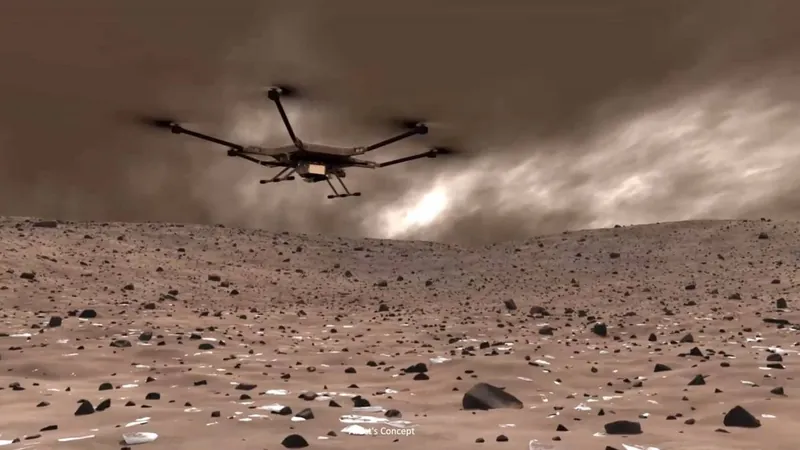
Meet 'Nighthawk': NASA's Ambitious Plan for Mars Exploration Takes Flight!
2025-04-05
Author: Siti
Introduction
NASA is gearing up for an exciting new chapter in Martian exploration with its innovative Mars helicopter mission, ‘Nighthawk’. Building on the monumental success of the Ingenuity drone, which completed an impressive 72 flights on the Red Planet, NASA is now developing a more sophisticated aerial vehicle, aptly named the Mars Chopper. This SUV-sized marvel will boast six rotors, each equipped with six blades designed to navigate the thin Martian atmosphere.
Unveiling of Nighthawk
The recent unveiling of the Nighthawk concept at the Lunar and Planetary Science Conference in The Woodlands, Texas, ignites curiosity among scientists and space enthusiasts alike. This advanced mission aims to operate independently, without requiring support from any rover, a significant step forward from Ingenuity’s reliance on the Perseverance rover.
Primary Mission Goals
Nighthawk’s primary mission involves exploring the intriguing Eastern Noctis Labyrinthus, a region rich in geological history, nestled between the Valles Marineris canyon system and the expansive Tharsis volcanic plateau. This area has long piqued the interest of scientists, primarily due to its diverse landscape characterized by interconnected canyons, dune fields, and lava flows.
Scientific Aspirations
Among its ambitious goals, Nighthawk seeks to uncover potential biomarkers in this deeply eroded volcanic region, which is assumed to be glaciated. The mission could also shed light on water features, volcanic histories, and the history of the colossal Noctis Volcano, potentially identified as a site for future human landings.
Technical Specifications
Equipped with a trio of advanced science payloads, Nighthawk is set to weigh in at just 6.6 pounds (3.0 kilograms) against an available 11 lbs (5 kg) of payload on the Mars Chopper. This efficiency will allow Nighthawk to soar to heights of 4,920 feet (1,500 meters) above the Martian surface, far above the altitude limits of Ingenuity, which operated at 1.6 miles (2.6 kilometers) below average Mars altitude.
Scientific Instruments
The scientific instruments on board include the OCCAM (Omni-directional Color CAMera), an eight-camera color imager for navigation and geological context, the NIRAC spectrometer and context camera, and PMWS (Puli Mars Water Snooper), a neutron detector for evaluating water abundance in the Martian subsurface. These tools will empower Nighthawk to conduct comprehensive studies over the course of at least 240 sols (Mars days), aiming for 100 flights that cover distances of up to 1.86 miles (3.0 kilometers) each.
Conclusion
As stated by Pascal Lee of NASA’s Ames Research Center, “Nighthawk's science mission would not be achievable with an Ingenuity-class helicopter, but could be accomplished with the larger, more capable NASA Mars Chopper currently under design.” The potential of Nighthawk has opened up a world of possibilities for future Mars exploration, although it remains uncertain when the mission could officially commence.
NASA's ambition stretches far beyond robotic exploration; this groundbreaking project could pave the way for human presence on Mars in the coming decades. Intrigued by what lies ahead? The journey of Nighthawk could redefine our understanding of Mars, keeping the dream of human colonization well within grasp. Stay tuned for updates as we set our sights on the thrilling future of Martian exploration!



 Brasil (PT)
Brasil (PT)
 Canada (EN)
Canada (EN)
 Chile (ES)
Chile (ES)
 Česko (CS)
Česko (CS)
 대한민국 (KO)
대한민국 (KO)
 España (ES)
España (ES)
 France (FR)
France (FR)
 Hong Kong (EN)
Hong Kong (EN)
 Italia (IT)
Italia (IT)
 日本 (JA)
日本 (JA)
 Magyarország (HU)
Magyarország (HU)
 Norge (NO)
Norge (NO)
 Polska (PL)
Polska (PL)
 Schweiz (DE)
Schweiz (DE)
 Singapore (EN)
Singapore (EN)
 Sverige (SV)
Sverige (SV)
 Suomi (FI)
Suomi (FI)
 Türkiye (TR)
Türkiye (TR)
 الإمارات العربية المتحدة (AR)
الإمارات العربية المتحدة (AR)